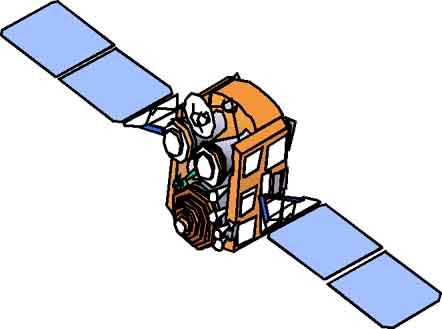DOT&E FY2000 Annual Report
WIDEBAND GAPFILLER SATELLITE (WGS)
 |
| Air Force ACAT ID Program | Prime Contractor | |
| Total Number of Systems: | 3 | TBD |
| Total Program Cost (TY$): | $900M | |
| Average Unit Cost (TY$): | $300M | |
| Full-rate production: | N/A |
SYSTEM DESCRIPTION & CONTRIBUTION TO JOINT VISION 2020
The Wideband Gapfiller Satellite (WGS) communications system provides communications to U.S. warfighters, Allies, and Coalition Partners during all levels of conflict short of nuclear war. It is the wideband component for the transition to the DoD's future Military Satellite Communications architecture. WGS will provide the warfighter with the information superiority necessary to act inside the decision cycle of the adversary, and execute precision engagement as the dominant maneuver force during activities leading up to and during armed conflict.
WGS will satisfy military communications needs by providing communications in both the X-band and military Ka-band frequencies. It will combine capabilities onto a single satellite for tactical X-band communications, augment the Global Broadcast Service (GBS) Phase II system, and provide new two-way Ka-band services. This new service is being introduced to alleviate the spectrum saturation of X-band, and will greatly increase both the available single-user data rate and total satellite capacity over today's Defense Satellite Communications System (DSCS) III satellites.
WGS will provide essential communications service for the Commanders in Chief to command and control their tactical forces in military operations short of nuclear war. Wideband Gapfiller provides connectivity with the terrestrial portion of the Defense Information Services Network, the Army Command and Control System, Marine Air Ground Task Force networks, Air Force wideband networks for Air Expeditionary Forces, and other intelligence data dissemination communications systems. WGS also provides high capacity communications links to support the Warfighter Information Network communications equipment nodes used to disseminate imagery and targeting update information.
BACKGROUND INFORMATION
WGS will join four X-band DSCS III/Service Life Extension Program satellites and three Ka-band UFO/GBS Phase II satellites in the DoD wideband constellation. Each geosyncronous Gapfiller satellite will operate in both X-band and military Ka-band. The Ka-band services will augment broadcast service provided by GBS payloads on UHF Follow-On (UFO) satellites and support two-way network services. The satellites will also support cross-banded service connectivity: X-band uplinks to Ka-band downlinks and Ka-band uplinks to X-band downlinks. All such design characteristics are notional at this writing; design specifics will be determined following completion of cost/performance trade-offs and finalization of scenario-driven requirements.
The program will be acquired under the Federal Acquisition Regulation Part 12 rules for commercial item acquisition. Because of its commercial nature, this program has no lead-in development phase, but will proceed directly from award to launch in one combined EMD/Production phase. The development schedule is three years, with first launch in 1QFY04. The final two launches are planned for 1Q and 3QFY05.
The 2001 Defense Appropriations Act signed on August 9, 2000, limited funding to two satellites. Subsequently, the Office of the Secretary of Defense signed a Program Decision Memorandum on August 22, 2000, supplementing WGS funding by $272.9 million to ensure system success. The WGS acquisition, as identified in the WGS System Operational Requirements Document (ORD) and per the Senior Warfighters Forum recommendation, will acquire three satellites.
TEST & EVALUATION ACTIVITY
The four major test activities will be: (1) an EOA conducted before the Milestone II/III decision; (2) an OA conducted during the Critical Design Review timeframe; (3) combined DT/OT testing conducted before Multi-Service Operational Test and Evaluation (MOT&E); and (4) MOT&E conducted prior to IOC.
MOT&E will include participation from the Air Force, (including the Air Force Information Warfare Center (AFIWC)), Army, Navy, Marines, and the Joint Interoperability Test Center (JITC). The Joint Spectrum Center will assist the OTAs in evaluating electromagnetic environmental effects. AFOTEC is the lead service OTA and will provide a test director. JITC, in concert with the OTAs, will perform Joint interoperability testing and provide the necessary interoperability certification. AFIWC will assist the OTAs in evaluating information assurance. The ORD and the WGS Concepts of Operation will be the primary sources of requirements. MOT&E will be conducted at various locations covering the numerous system C2 nodes, and will support the IOC declaration.
TEST & EVALUATION ASSESSMENT
AFOTEC conducted an EOA of the Wideband Gapfiller Satellite system to support a combined Milestone II/III decision. Data collected during the scope/cost process contributed to the development of this assessment.
The complexity of cross-banding between the X-band and Ka-band on board the satellite, and the concurrent development of the Gapfiller Satellite Configuration Control Element (GSCCE) with the automation upgrades of the Satellite Operations Center and Defense Satellite Communications System (DSCS) Operations Center (DSCSOC) networks, pose a risk to successful WGS development and implementation.
Interoperability requirements compound the complexity of developing the control software for WGS. The GSCCE used to control WGS payloads must be interoperable with the Defense Satellite Communications System Operations Center network. A software development program is ongoing which will upgrade the DSCSOC network to a new ODOCS system; this is separate from the concurrent program that will produce the GSCCE. If the GSCCE and the ODOCS are not interoperable, the DSCSOC operators will not be able to successfully establish communication networks with operational users.
Additionally, the Wideband Gapfiller Satellite and the Global Broadcast System must be interoperable. GBS has a separate support infrastructure to control the payloads on the UFO satellites and for structuring broadcasts to users in the field. WGS payloads (to include Ka-band) are proposed to be controlled by the DSCSOC's, currently only capable of controlling X-band payloads. Interoperability between these two systems must be synergistic and not compete to ensure high-speed access for broadcast users.
FY00 WIDEBAND GAPFILLER SATELLITE (WGS)
|
NEWSLETTER
|
| Join the GlobalSecurity.org mailing list |
|
|
|

